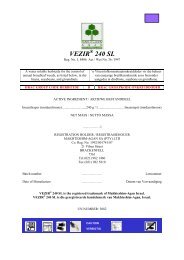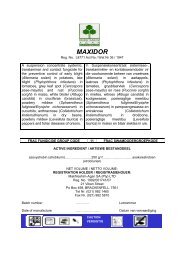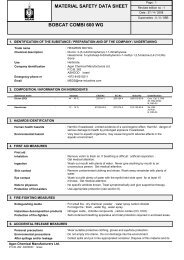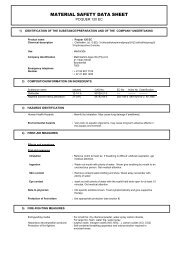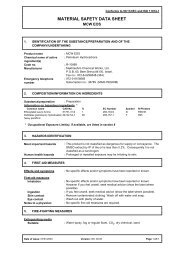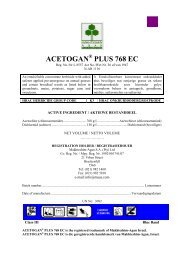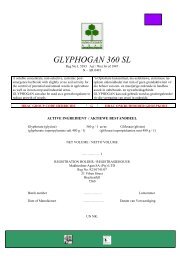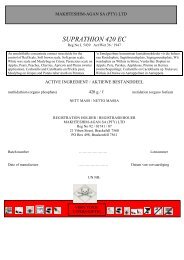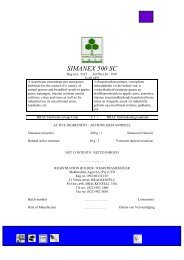METHOMEX 900 SP - Makhteshim-Agan SA (Pty) Ltd
METHOMEX 900 SP - Makhteshim-Agan SA (Pty) Ltd
METHOMEX 900 SP - Makhteshim-Agan SA (Pty) Ltd
You also want an ePaper? Increase the reach of your titles
YUMPU automatically turns print PDFs into web optimized ePapers that Google loves.
<strong>METHOMEX</strong> <strong>900</strong> <strong>SP</strong><br />
Reg no L 5254 Act / Wet No 36 of 1947<br />
N-AR 0498<br />
A water soluble liquid insecticide for the<br />
control of pests in crops as indicated.<br />
‘n Wateroplosbare vloeistof insekdoder vir die<br />
beheer van plae in gewasse soos aangedui.<br />
IRAC INSECTICIDE GROUP CODE 1A IRAC INSEKDODERGROEPKODE<br />
ACTIVE INGREDIENT / AKTIEWE BESTANDDEEL<br />
Methomyl (carbamate) ................................ <strong>900</strong> g / kg............................. Metomil (karbamaat)<br />
Net Volume ....................................................... kg.............................................. Netto Volume<br />
REGISTRATION HOLDER / REGISTRASIEHOUER<br />
MAKHTESHIM-AGAN <strong>SA</strong> (PTY) LTD<br />
Reg no 1992/001741/07<br />
21 Viben Street<br />
BRACKENFELL<br />
7561<br />
Tel (021) 982 1460<br />
Fax (021) 982 5810<br />
Batch Number........................................................................................................... Lotnommer<br />
Date of Manufacture..................................................................................Vervaardigingsdatum<br />
UN NUMBER: 2992<br />
(red / rooi)
WARNINGS<br />
WITHOLDING PERIOD: Number of days which should be allowed between the last application<br />
and harvest or grazing (feeding) of the crop:<br />
Barley........................................................................................................................................ 35 days<br />
Beans......................................................................................................................................... 14 days<br />
Citrus – 20g / 100l dosage.......................................................................................................... 2 days<br />
Citrus – greater than 20g / 100l dosage.................................................................................... 28 days<br />
Cruciferae.................................................................................................................................... 4 days<br />
Grain sorghum, maize, pastures, wheat, lupins, lucerne, tobacco (flue-cured) .......................... 7 days<br />
Peaches...................................................................................................................................... 16 days<br />
Potatoes....................................................................................................................................... 3 days<br />
Tobacco (air- cured).................................................................................................................. 14 days<br />
Tomatoes..................................................................................................................................... 2 days<br />
<strong>METHOMEX</strong> MAY CAUSE YELLOWING OF THE LEAF TIPS WHEN USED ON<br />
CERTAIN CARNATION VARIETIES.<br />
DO NOT USE <strong>METHOMEX</strong> IN COMBINATION WITH G49 WETTING AGENT ON<br />
TABOCCO SEEDBEDS OR CITRUS.<br />
• Handle with extreme care.<br />
• Poisonous by contact, swallowing or inhalation – small quantity may be fatal if swallowed or<br />
inhaled.<br />
• Toxic to fish, bees and wildlife.<br />
• Store under lock and key, away from foodstuffs.<br />
• Keep container well closed. Keep out of reach of children, animals and uninformed persons.<br />
• In case of poisoning, call a doctor immediately and make this label available.<br />
Aerial application: Notify all inhabitants in the immediate vicinity of the area to be sprayed and<br />
issue the necessary warnings. Do not apply over water or adjacent areas that are not under treatment,<br />
or allow the spray mist to drift over these areas.<br />
Although this remedy has been extensively tested under a large variety of conditions, the<br />
registration holder does not guarantee that it will be effective under all conditions. The activity<br />
and effect thereof may be affected by factors such as abnormal soil, climatic and storage<br />
conditions, quality of dilution water, compatibility with other substances not indicated on the<br />
label and the occurrence of resistance of the pests against the remedy as well as by the method,<br />
time and accuracy of application. The registration holder furthermore does not accept<br />
responsibility for damage to crops, vegetation, the environment or harm to man or animal or<br />
for lack of performance of the remedy concerned due to failure by the user to follow the label<br />
instructions, or to the occurrence of conditions which could not have been foreseen in terms of<br />
the registration. Consult the supplier in the event of any uncertainty.<br />
PRECAUTIONS<br />
• Avoid inhalation of spray mist and fumes and contact with eyes, skin or clothing.<br />
• Wear protective clothing (overall, rubber boots, gloves and respirator).<br />
• Wash contaminated clothing daily.<br />
• In case of skin contact, wash thoroughly with soap and water. Do not eat, drink or smoke<br />
while applying or preparing the spray mix, or before washing face and hands.<br />
• Prevent drift of spray onto other crops, grazing, rivers and any area not under treatment.<br />
• Prevent contamination of food, feeds, drinking water and eating utensils.
• Clean applicator before using for other materials and dispose of wash water where it will not<br />
contaminate crops, grazing, rivers or dams.<br />
• Destroy empty container in the prescribed manner and never use for any other purpose.<br />
SYMPTOMS OF HUMAN POISONING<br />
Headache, fatigue, faintness, giddiness, excessive sweating, nausea, abdominal pains, vomiting,<br />
blurred vision, muscle twitching, small pupils, respiratory distress and coma.<br />
FIRST AID TREATMENT<br />
• Remove patient from source of poisoning to a cool, well-ventilated area and keep him quiet<br />
and reassured.<br />
• Remove contaminated clothing and rinse contaminated body area thoroughly with plenty of<br />
soap and cold water. Do not rub skin.<br />
• Flush contamination out of eyes with clean water for at least 15 minutes.<br />
• If swallowed, induce vomiting by tickling the back part of the throat. Repeat until vomit fluid<br />
is clear and free from smell of poison. Take the patient immediately to the nearest physician.<br />
Administer artificial respiration or closed chest massage if necessary. Do not apply direct mouth-tomouth<br />
respiration. Never give anything by mouth to an unconscious person.<br />
NOTE TO PHYSICIAN<br />
Administer Atropine sulphate intravenously (1-4 mg) every 5 to 15 minutes until signs of<br />
atropinization (dry flushed skin and tachycardia) appear. Pralidoxyme (2-PAM, Protopam) and other<br />
oximes are contra-indicted.
DIRECTIONS FOR USE: USE ONLY AS INDICATED.<br />
MIXING INSTRUCTIONS<br />
Add the required amount to a half-full spray tank and mix thoroughly and fill up slowly while<br />
agitating (mechanical or hydraulic). Commence agitating of mixture a few minutes before starting to<br />
spray. Agitation is necessary to ensure thorough mixing of insecticide.<br />
Aerial application:<br />
Aerial application of <strong>METHOMEX</strong> <strong>900</strong> <strong>SP</strong> may only be done by a registered Aerial Application<br />
Operator using a correctly calibrated, registered aircraft according to the instructions of <strong>SA</strong>BS Code<br />
0118 (Aerial Application of Agricultural Pesticides). Ensure that the spray mixture is distributed<br />
evenly over the target area and that the loss of spray material during application is restricted to a<br />
minimum. It is therefore essential that the following criteria be met:<br />
• Volume: A spray mixture volume of 30 litres per hectare is recommended. As this product has<br />
not been evaluated at a reduced rate, the registration holder cannot guarantee efficacy, or be held<br />
responsible for any adverse effects if this product is applied aerially at a lower volume than<br />
recommended above.<br />
• Droplet coverage: 30 to 40 droplets per cm² must be recovered at the target area.<br />
• Droplet size: A droplet spectrum with a VMD of 250 to 280 microns is recommended. Limit the<br />
production of fine droplets less than 150 microns (high drift and evaporation potential) to a<br />
minimum.<br />
• Flying height: Maintain the height of the spray boom at 3 to 4 metres above the target. Do not<br />
spray when aircraft dives, is in a climb or when banking<br />
• Use suitable atomising equipment that will produce the desired droplet size and coverage, but<br />
which will ensure the minimum loss of product. The spraying system must produce a droplet<br />
spectrum with the lowest possible Relative Span.<br />
• Position all the atomisers within the inner 60 to 75 % of the wingspan to prevent droplets from<br />
entering the wingtip vortices.<br />
• The difference in temperature between the wet and dry bulb thermometers, of a whirling<br />
hygrometer, should not exceed 8°C.<br />
• Stop spraying if the wind speed exceeds 15 km/h.<br />
• Stop spraying under turbulent, unstable and dry conditions during the heat of the day.<br />
• Spraying under temperature inversion conditions (spraying in or above the inversion layer) and/or<br />
high humidity conditions (relative humidity 80 % and above) may lead to the following:<br />
a) reduced efficacy due to suspension and evaporation of small droplets in the air (inadequate<br />
coverage).<br />
b) damage to other sensitive crops and/or non-target areas through drifting of the suspended<br />
spray cloud away from the target field.<br />
• Ensure that the Aerial Spray Operator knows exactly which fields to spray.<br />
• Obtain an assurance from the Aerial Spray Operator that the above requirements will be met and<br />
that relevant data will be compiled in a logbook and kept for future reference.
CROP AND DISEASE DO<strong>SA</strong>GE REMARKS<br />
BARLEY<br />
African bollworm<br />
(Helicoverpa armigera)<br />
200g / ha<br />
Only to be used under the<br />
recommendation of <strong>SA</strong>B Maltings<br />
Ground application: Low volume.<br />
Apply 200l water.<br />
BEANS<br />
African bollworm<br />
(Helicoverpa armigera)<br />
CARNATIONS<br />
Carnation worm<br />
(Epichoristodes acerbella)<br />
CITRUS<br />
Aphids<br />
(Toxoptera citricida<br />
Aphis gossypii)<br />
African bollworm<br />
(Helicoverpa armigera)<br />
Mealybugs<br />
(Planococcus citri<br />
Nipaecoccus vastator<br />
Paracoccus burnerae)<br />
Orange dog caterpillar<br />
(Papilio spp)<br />
Red scale<br />
(Aonidiella aurantii)<br />
Soft green scale<br />
(Pulvinaria aethiopica)<br />
Waxy scale<br />
(Gascardia destructor)<br />
250g / ha<br />
100g / 100l water<br />
20g / 100l water<br />
20g / 100l water<br />
25g / 100l water<br />
100g plus 3l light<br />
narrow range mineral<br />
oil per 100l water.<br />
20g plus 500ml light<br />
narrow range mineral<br />
oil / 100l water.<br />
25g / 100l water<br />
Aerial application: Apply in 30l water as<br />
soon as worms appear. Repeat if necessary.<br />
Ground application: Ensure good<br />
coverage on the plants and apply up to 500l<br />
spray mixture / ha.<br />
Aerial application: Apply in 30l water as<br />
soon as infestation appears. Repeat if<br />
necessary.<br />
Ensure good coverage of the whole plant.<br />
Repeat weekly.<br />
Apply as a full cover spray when aphids<br />
and / or worms appear. Repeat when<br />
necessary.<br />
Apply as a full cover spray with a high<br />
pressure sprayer as soon as young nymphs<br />
appear on the fruit. Repeat if necessary.<br />
Apply as a light cover spray as soon as<br />
larvae are noticed.<br />
Corrective treatment: Apply when 25 to<br />
40% of the fruit is infested with one or<br />
more live nymphs or adult scale.<br />
WARNING: Fruit bearing trees: Only<br />
one application must be made between<br />
December and March for late cultivars.<br />
Early cultivars may only be sprayed in<br />
December or January and not later than<br />
January. Application must be made with<br />
high pressure air compressor handguns. Do<br />
not apply with conventional citrus spray<br />
rigs.<br />
Apply as a full cover spray with a high<br />
pressure pump when the first visible signs<br />
of infestation are seen. Do not use less than<br />
500ml oil / 100l water.<br />
Apply as a full cover spray with a high
CRUCIFERAE<br />
Larvae of the Diamond back<br />
moth<br />
(Plutella xylostella)<br />
Greater cabbage moth<br />
(Crocidolomia binotalis)<br />
Aphids<br />
(Brevicoryne brassicae)<br />
African bollworm<br />
(Helicoverpa armigera)<br />
GRAIN SORGHUM,<br />
WHEAT, LUPINS AND<br />
LUCERNE<br />
African bollworm<br />
(Helicoverpa armigera)<br />
GRAZING AND OTHER<br />
CROPS<br />
Army worm<br />
(Spodoptera exempta)<br />
MAIZE<br />
African bollworm<br />
(Helicoverpa armigera)<br />
PEACHES<br />
False codling moth<br />
(Cryptophlebia leucotreta)<br />
50g / 100l water<br />
250g / ha<br />
200g / ha<br />
200g / ha<br />
50g / 100l water<br />
50g / ha<br />
200g / ha<br />
200g / ha<br />
50g / 100l water<br />
50g / 100l<br />
pressure pump as young nymphs of a new<br />
generation move from the leaves to the<br />
twigs. This treatment will not be<br />
successful against adult waxy scale.<br />
Apply when worms first appear on the<br />
leaves. Use up to 500l spray mixture / ha.<br />
During hot weather and peak infestations,<br />
shorten the spray intervals to between 3 and<br />
5 days. Ensure thorough wetting of the<br />
plants.<br />
Ground application: Apply in sufficient<br />
water to ensure good coverage.<br />
Aerial application: Apply in 30l water as<br />
soon as worms appear. Repeat if necessary.<br />
Aerial application: Apply in 30l water<br />
when pests are noticed. Repeat as<br />
necessary.<br />
Ground application: Low volume.<br />
Apply in 200l water.<br />
Apply up to 400l spray mixture / ha.<br />
Ground application: Apply in 400l water<br />
as soon as pest is noticed.<br />
Aerial application: Apply in 30l water as<br />
soon as worms are noticed on the silks.<br />
<strong>METHOMEX</strong> will not control worms<br />
which have already entered the cob.<br />
Ground application: Low volume.<br />
Apply in 200l water.<br />
Apply up to 400l spray mixture / ha.<br />
Early cultivars: Apply two sprays<br />
ensuring that the tree is thoroughly wetted.<br />
Apply the first spray 4 weeks before<br />
harvest and the second 10 days later. Also<br />
apply a registered product for fruit fly<br />
control.<br />
POTATOES<br />
Potato tuber moth<br />
(Phthorimaea operculella)<br />
Late cultivars: Apply three sprays<br />
beginning 6 weeks before harvest and<br />
repeat at 10 day intervals. Ensure good<br />
coverage of the trees. Also apply a<br />
registered product for fruit fly control.<br />
300 – 500g / ha Aerial application: Apply in 30l water.<br />
Use the higher dosage if the spray interval<br />
exceeds one week.
African bollworm<br />
(Helicoverpa armigera)<br />
ROSES<br />
Aphids<br />
(Macrosiphum rosae)<br />
TOBACCO<br />
Leafminer<br />
(Phthorimaea operculella)<br />
African bollworm<br />
(Helicoverpa armigera)<br />
Tobacco slug<br />
(Oulema bilineata)<br />
Stinkbug<br />
(Pentatomidae spp)<br />
African bollworm<br />
(Helicoverpa armigera)<br />
Tobacco slug<br />
(Oulema bilineata)<br />
Stinkbug<br />
(Pentatomidae spp)<br />
TOMATOES<br />
African bollworm<br />
(Helicoverpa armigera)<br />
Leafminer<br />
(Phthorimaea operculella)<br />
Aphids<br />
(Aphididae spp)<br />
Thrips<br />
(Thrips tabaci)<br />
50g / 100l water<br />
25g / 100l water<br />
50g / 100l water<br />
250g / ha<br />
50g / 100l water<br />
For tuber moth, begin application as soon<br />
as the plant is one month old and repeat<br />
applications weekly throughout the growing<br />
season. Potatoes must be ridged at least<br />
twice during the growing season. For<br />
African bollworm one application is<br />
enough to control one outbreak. If further<br />
outbreaks occur, repeat application as<br />
necessary.<br />
Ground application: Ensure good<br />
coverage and wetting of the plant. Apply<br />
up to 1000l spray mixture / ha.<br />
Apply as a full cover spray. Repeat as<br />
necessary. Apply up to 500l spray mixture<br />
/ ha.<br />
Ground application: Apply when pests<br />
are noticed. For leafminer, spray weekly<br />
and ensure thorough wetting of plants.<br />
Apply up to 500l spray mixture / ha.<br />
Aerial application: Apply in 30l water<br />
when pests are noticed. Repeat as<br />
necessary.<br />
Apply as a full cover spray as soon as fruit<br />
begins to set or earlier if necessary, and<br />
repeat at 7 to 10 day intervals during the<br />
growing season.
WAARSKUWINGS:<br />
ONTHOUDING<strong>SP</strong>ERIODE: Aantal dae wat moet verskryk tussen die laaste toediening en oes of<br />
beweiding (voer) van die gewas.<br />
Aartappels .....................................................................................................................................3 dae<br />
Bone............................................................................................................................................14 dae<br />
Gars........................................................................................................................................... 35 days<br />
Graansorghum, mielies, weidings, koring, lupine, lusern, tabak(oonddroog) ..............................7 dae<br />
Koolgewasse .................................................................................................................................4 dae<br />
Perskes ........................................................................................................................................16 dae<br />
Sitrus – 20g / 100l dosis...............................................................................................................2 dae<br />
Sitrus – hoër as 20g / 100l dosis.................................................................................................28 dae<br />
Tabak (lugdroog) ........................................................................................................................14 dae<br />
Tamaties........................................................................................................................................2 dae<br />
<strong>METHOMEX</strong> MAG OP SEKERE ANGELIERVARIëTEITE VERGELING VAN DIE<br />
BLAARPUNTE VEROOR<strong>SA</strong>AK.<br />
MOET NIE <strong>METHOMEX</strong> IN KOMBINASIE MET G49 BENATTINGSMIDDEL OP<br />
TABAKBEDDINGS OF OP SITRUS GEBRUIK NIE.<br />
• Hanteer uiters versigtig.<br />
• Giftig deur kontak, inname of inaseming van ‘n baie klein hoeveelheid mag dodelik wees.<br />
• Giftig vir visse, bye en wild.<br />
• Stoor agter slot en grendel en weg van voedsel en voer.<br />
• Hou buite bereik van kinders, diere en oningeligte persone.<br />
• In geval van vergiftiging, ontbied ‘n geneesheer en toon hierdie etiket.<br />
Lugtoediening: Stel alle inwoners in die onmiddellike omgewing van die gebied wat bespuit gaan<br />
word in kennis en reik die nodige waarskuwings uit. Moet nie oor water of aanliggende gebiede wat<br />
nie behandel word toedien of toelaat dat die spuitnewel oor die gebiede dryf nie.<br />
Alhoewel hierdie middel omvattend onder ‘n groot verskeidenheid toestande getoets is,<br />
waarborg die registrasiehouer nie dat dit onder alle toestande doeltreffend sal wees nie. Die<br />
werking en doeltreffendheid daarvan kan beïnvloed word deur faktore soos abnormale grond,<br />
klimaats- en bergingstoestande, kwaliteit van die verdunningswater, verenigbaarheid met ander<br />
stowwe wat nie op die etiket aangedui word nie en die voorkoms van weerstand van die plae<br />
teen die betrokke middel sowel as die tyd en akkuraatheid van toediening. Verder aanvaar die<br />
registrasiehouer nie verantwoordelikheid vir skade aan gewasse, plantegroei en die omgewing of<br />
nadelige invloede op mens of dier of vir ‘n gebrek aan prestasie van die betrokke middel as<br />
gevolg van versuim van die gebruiker om etiketaanwysings na te kom, of as gevolg van die<br />
onstaan van toestande wat nie kragtens die registrasie voorsien kon word nie. Raadpleeg die<br />
verskaffer in die geval van enige onsekerheid.<br />
VOORSORGMAATREëLS:<br />
• Voorkom inaseming van dampe en sproeinewel en kontak met die oë, vel of klere.<br />
• Dra beskermende klere (oorpak, rubberstewels, handskoene en respirator).<br />
• Was besoedelde klere daagliks.<br />
• In geval van toevallige velkontak was met seep en water.<br />
• Moet nie eet, drink of rook tydens toediening of vermenging nie, of voordat gesig en hande<br />
gewas is nie.
• Voorkom oorwaai van spuitnewel na ander gewasse, weiding, riviere, damme en enige ander<br />
gebied wat nie behandel word nie.<br />
• Voorkom besoedeling van voedsel, voer, drinkwater en eetgerei.<br />
• Maak die apparaat skoon voordat dit vir ander middels gebruik word en raak ontslae van die<br />
spoelwater waar dit nie gewasse, weidings, riviere of damme sal besoedel nie.<br />
• Vernietig leë houer deur gate daarin te maak en plat te druk.<br />
• Moet vir geen ander doel gebruik nie.<br />
SIMPTOME VAN MENSLIKE VERGIFTIGING:<br />
Hoofpyn, vermoeidheid, floute, duiseligheid, oormatige sweet, mislikheid, buikpyn, braking,<br />
benoudheid, versteurde gesigsvermoë, spiertrekkings, gewoonlik verkleinde pupille, asemhalingsnood<br />
en bewusteloosheid.<br />
NOODBEHANDELING:<br />
• Verwyder pasiënt van die oorsaak van vergiftiging na ‘n koel, goed geventileerde omgewing.<br />
Stel hom gerus en hou hom stil.<br />
• Verwyder besoedelde klere en spoel die besmette liggaamsdele met baie seep en koue water<br />
af. Moenie die vel hard vryf nie.<br />
• Besmette oë moet vir tenminste 15 minute met skoon water uitgespoel word.<br />
• Indien per mond ingeneem, veroorsaak braking deur die agterste gedeelte van die keel te<br />
prikkel met u vinger. Herhaal todat braaksel helder is en nie langer na gif ruik nie. Neem die<br />
pasient onmiddelik na die naaste genesheer. Pas kunsmatige asemhaling of geslote<br />
hartmassering toe indien nodig.<br />
• Moenie direkte mond-tot-mond asemhaling toepas nie.<br />
• Moet nooit iets per mond aan ‘n bewustelose persoon toedien nie.<br />
NOTA AAN DIE GENEESHEER:<br />
Dien atropiensulfaat binneaars (1- 4 mg) toe elke 5 tot 10 minute tot die eerste teken van atropinisasie<br />
(droè gloeiende vel en tachycardia) voorkom. Palidoxime (2-PAM, Protopam) en ander oksieme<br />
moet nie gebruik word nie.
GEBRUIK<strong>SA</strong>ANWYSINGS: GEBRUIK SLEGS SOOS AANGEDUI<br />
VERMENINGSVOORSKRIFTE:<br />
Voeg die benodigde hoeveelheid by die half vol spuittenk en meng deeglik deur roering terwyl die<br />
spuittenk stadig volgemaak word (meganies of hidrolies). Roering is noodsaaklik om die insekdoder<br />
goed te vermeng.<br />
Lugtoediening:<br />
<strong>METHOMEX</strong> <strong>900</strong> <strong>SP</strong> kan slegs deur ‘n geregistreerde Lugbespuitingsperateur met ‘n korrek<br />
gekalibreerde, geregistreerde vliegtuig volgens die instruksies van <strong>SA</strong>BS Kode 0118 (Aerial<br />
Application of Agricultural Pesticides) uit die lug bespuit word. Verseker dat die spuitmengsel<br />
eweredig oor die teikenarea versprei word, en die verlies aan spuitmengsel tydens toediening tot ‘n<br />
minimum beperk word. Dit is daarom belangrik om aan die volgende vereistes te voldoen:<br />
• Volume: ‘n Spuitmengsel volume van 30 tot 40 liter per ha word aanbeveel. Hierdie produk<br />
is nie teen ‘n verlaagde volume getoets nie. Die registrasiehouer kan nie effektiteit waarborg,<br />
of verantwoordelik gehou word vir enige nadelige effekte indien hierdie produk teen ‘n laer<br />
volume, as hierbo aanbeveel, toegedien word nie.<br />
• Druppel bedekking: 30 tot 45 druppels per cm² moet op die teikenarea herwin word.<br />
• Druppelgrootte: ‘n Druppelspektrum met ‘n VMD van 280 tot 300 mikrons word aanbeveel.<br />
Beperk die produksie van druppels kleiner as 150 mikrons (hoë drywing en<br />
verdampingspotensiaal) tot ‘n minimum.<br />
• Vlieghoogte: Handhaaf die hoogte van die spuitbalk bo die teiken op 3 tot 4 meter. Moet nie<br />
spuit wanneer die vliegtuig duik nie, uitklim of draai nie.<br />
• Gebruik geskikte atomiseringsapparaat wat die vereiste druppelgrootte en bedekking sal<br />
produseer, maar die minste verlies van produk verseker. Die spuitstelsel moet ‘n<br />
druppelspektrum met die kleinste moontlike Relatiewe Span produseer.<br />
• Plaas al die atomiseerders in die binnste 60 tot 75 % van die vlerkspan om te verhoed dat<br />
druppels binne-in die vlerkpuntvorteks beweeg.<br />
• Die verskil in temperatuur tussen die nat- en droëboltermometer van ‘n swaaihigrometer,<br />
moet nie 8°C oorskry nie.<br />
• Stop bespuiting indien die windspoed 15 km/h oorskry.<br />
• Stop bespuiting tydens turbulente, onstabiele en droë toestande gedurende die hitte van die<br />
dag.<br />
• Bespuiting onder temperatuur inversie toestande (deur bo of binne die inversie laag te spuit)<br />
en/of hoë lugvog toestande (relatiewe humiditeit 80% en meer) mag tot volgende probleme<br />
aanleiding gee:<br />
a) verlaagde effektiwiteit aangesien die druppels as ‘n wolk in die lug bly hang en moontlik<br />
verdamp (onvoldoende bedekking op teiken).<br />
b) skade aan nie-teiken gewasse of sensitiewe areas as gevolg van wegdrywing van die<br />
spuitwolk na nie-teiken area.<br />
• Verseker dat die Lugbespuitingsoperateur presies weet watter lande bespuit moet word.<br />
• Dit is noodsaaklik om ‘n versekering van die Lugbespuitingsoperateur te verkry dat aan al die<br />
bogenoemde vereistes voldoen sal word en dat data van belang in ‘n logboek saamgevat is vir<br />
toekomstige verwysing.
GEWAS EN PLAAG DOSIS OPMERKINGS<br />
AARTAPPELS<br />
Aartappelmot<br />
(Phthorimaea operculella)<br />
Afrika bolwurm<br />
(Helicoverpa armigera)<br />
ANGELIERE<br />
Angelierwurm<br />
(Epichoristodes acerbella)<br />
BONE<br />
Afrika bolwurm<br />
(Helicoverpa armigera)<br />
GARS<br />
Afrika bolwurm<br />
(Helicoverpa armigera)<br />
GRAANSORGHUM,<br />
KORING, LUPIENE EN<br />
LUSERN<br />
Afrika bolwurm<br />
(Helicoverpa armigera)<br />
KOOLGEWASSE<br />
Larwes van die Ruitrusmot<br />
(Plutella xylostella)<br />
Grootkoolmot<br />
(Crocidolomia binotalis)<br />
Plantluise<br />
(Brevicoryne brassicae)<br />
300 – 500g / ha<br />
50g / 100l water<br />
100g / 100l water<br />
250g /ha<br />
200g / ha<br />
200g / ha<br />
200g / ha<br />
50g / 100l water<br />
50g / 100l water<br />
Lugtoediening: Dien toe in 30l water.<br />
Gebruik die hoë dosis as die spuitintervalle<br />
langer as een week is.<br />
Vir aartappelmot begin toediening sodra<br />
die plant een maand oud is en herhaal<br />
toedienings weekliks gedurende die<br />
groeiseisoen. Aartappels moet ten minste<br />
twee maal gedurende die groeiseisoen<br />
opge-erd word. Vir Afrika bolwurm is een<br />
toediening genoeg om een infestasie te<br />
beheer. Indien verdere infestasies<br />
plaasvind herhaal toediening soos nodig.<br />
Grondtoediening: Sorg vir ‘n goeie<br />
bedekking en benatting van die plant. Dien<br />
tot 1000l spuitmengsel / ha toe.<br />
Sorg vir goeie bedekking van die hele<br />
plant. Herhaal weekliks.<br />
Grondtoediening: Sorg vir goeie<br />
benatting van plante en dien tot 500l<br />
spuitmengsel / ha toe.<br />
Lugtoediening: Dien in 30l water toe<br />
sodra infestasie verskyn. Herhaal soos<br />
nodig.<br />
Slegs vir gebruik onder aanbeveling van<br />
<strong>SA</strong>B Maltings<br />
Grondtoediening: Lae volume. Dien in<br />
200l water toe.<br />
Lugtoediening: Dien toe in 30l water<br />
sodra die wurms hulle verskyning maak.<br />
Herhaal indien nodig.<br />
Lugtoediening: Dien in 30l water toe<br />
sodra die plaag opgemerk word. Herhaal<br />
indien nodig.<br />
Grondtoediening: Lae volume. Dien in<br />
200l water toe.<br />
Dien tot 400l spuitmengsel / ha toe.<br />
Dien toe wanneer die wurms vir die eerste<br />
keer op die blare verskyn. Gebruik tot<br />
500l spuitmengsel / ha. Gedurende warm<br />
weer en hoë infestasies, verkort die<br />
spuitintervalle na tussen 3 tot 5 dae. Sorg<br />
dat plante deeglik benat word.
Afrika bolwurm<br />
(Helicoverpa armigera)<br />
MIELIES<br />
Afrika bolwurm<br />
(Helicoverpa armigera)<br />
PERSKES<br />
Valskodling mot<br />
(Cryptophlebia leucotreta)<br />
ROSE<br />
Plantluise<br />
(Macrosiphum rosae)<br />
SITRUS<br />
Plantluise<br />
(Toxoptera citricida<br />
Aphis gossypii)<br />
Afrika bolwurm<br />
(Helicoverpa armigera)<br />
Witluise<br />
(Planococcus citri<br />
Nipaecoccus vastator<br />
Paracoccus burnerae)<br />
Lemoenvlinder<br />
(Papilio spp)<br />
Rooidopluis<br />
(Aonidiella aurantii)<br />
250g / ha<br />
200g / ha<br />
200g / ha<br />
50g / 100l water<br />
50g / 100l water<br />
25g / 100l water<br />
20g / 100l water<br />
2 g / 100l water<br />
25g / 100l water<br />
100g plus 3l ligte<br />
smalbestek olie / 100 l<br />
water<br />
Lugtoediening: Dien toe in 30l water<br />
sodra die wurms hulle verskyning maak.<br />
Herhaal indien nodig.<br />
Grondtoediening: Dien toe in voldoende<br />
water om ‘n goeie bedekking te verseker.<br />
Lugtoediening: Dien toe in 30l water<br />
sodra ruspes op die baard opgemerk word.<br />
<strong>METHOMEX</strong> sal nie ruspes wat reeds die<br />
kop binnegedring het, doodmaak nie.<br />
Grondtoediening: Lae volume. Dien in<br />
200l water toe.<br />
Dien tot 400l spuitmengsel / ha toe.<br />
Vroeë kultivars: Dien twee bespuitings<br />
toe en sorg dat die boom deeglik benat<br />
word. Dien die eerste bespuiting tot 4<br />
weke voor oes en die tweede, 10 dae later.<br />
Dien ook ‘n geregistreerde produk vir die<br />
beheer van vrugtevlieg toe.<br />
Laat kultivars: Dien drie bespuitings toe<br />
en begin 6 weke voor oes en herhaal met<br />
tussenposes van 10 dae. Verseker goeie<br />
bedekking van die bome. Dien ook ‘n<br />
geregistreerde produk toe vir die beheer<br />
van vrugtevlieg.<br />
Dien toe as ‘n volle dekbespuiting. Herhaal<br />
soos nodig. Dien tot 500l spuitmengsel /<br />
ha toe.<br />
Dien toe as ‘n volle dekbespuiting wanneer<br />
die plantluise en /of ruspes verskyn.<br />
Herhaal indien nodig.<br />
Dien toe as ‘n volle dekbespuiting met ‘n<br />
hoëdrukspuitpomp sodra die jong nimfe op<br />
die vrugte verskyn. Herhaal indien nodig.<br />
Dien toe as ‘n ligte dekbespuiting sodra die<br />
larwes opgemerk word.<br />
Korrektiewe behandeling: Dien toe<br />
wanneer 25 tot 40% van die vrugte besmet<br />
is met een of meer lewendige nimfe of<br />
volwasse dopluise.<br />
WAARSKUWING: Vrugdraende bome:<br />
Slegs een behandeling moet op laat<br />
kultivars tussen Desember en Maart<br />
toegedien word. Vroeë kultivars mag slegs
Sagte groendopluis<br />
(Pulvinaria aethiopica)<br />
Wasdopluis<br />
(Gascardia destructor)<br />
TABAK<br />
Blaarmyner<br />
(Phthorimaea operculella)<br />
Afrika bolwurm<br />
(Helicoverpa armigera)<br />
Tabakslak<br />
(Oulema bilineata)<br />
Stinkbesie<br />
(Pentatomidae spp)<br />
Afrika bolwurm<br />
(Helicoverpa armigera)<br />
Tabakslak<br />
(Oulema bilineata)<br />
Stinkbesie<br />
(Pentatomidae spp)<br />
TAMATIES<br />
Afrika bolwurm<br />
(Helicoverpa armigera)<br />
Plantluise<br />
(Aphididae spp)<br />
Blaarmyner<br />
(Phthorimaea operculella)<br />
Blaaspootjies<br />
(Thrips tabaci)<br />
WEIDING EN ANDER<br />
GEWASSE<br />
Kommandowurm<br />
(Spodoptera exempta)<br />
20g plus 500ml ligte<br />
smalbestek minerale<br />
olie / 100l water.<br />
25g / 100l water<br />
50g / 100l water<br />
250g / ha<br />
50g / 100l water<br />
50g / ha<br />
in Desember of Januarie en ook nie later as<br />
Januarie, bespuit word nie. Behandeling<br />
moet met ‘n hoëdruk lugperspomp /<br />
handapparaat toegedien word. Moet nie<br />
met die konvensionele sitrusspuittoestelle<br />
toedien nie.<br />
Dien toe as ‘n volle dekbespuiting met ‘n<br />
hoëdrukpomp wanneer eerste tekens van<br />
infestasie opgemerk word. Moet nie<br />
minder as 500ml minerale olie / 100l<br />
water gebruik nie.<br />
Dien toe as ‘n volle dekbespuiting met ‘n<br />
hoëdrukpomp sodra die jong nimfe van ‘n<br />
nuwe geslag van die blare na die takkies<br />
beweeg. Hierdie behandeling sal nie<br />
suksesvol teen volwasse wasdopluise<br />
wees nie.<br />
Grondtoediening: Dien toe wanneer plaag<br />
opgemerk word. Vir blaarmyner spuit<br />
weekliks en verseker deeglike benatting<br />
van plante. Dien 500l spuitmengsel / ha<br />
toe.<br />
Lugtoediening: Dien toe in 30l water<br />
wanneer plaag opgemerk word. Herhaal<br />
soos nodig.<br />
Dien toe as ‘n volle dekbespuiting met<br />
vrugset of vroeër indien nodig en herhaal<br />
met tussenposes van 7 tot 10 dae gedurende<br />
die groeiseisoen.<br />
Grondtoediening: Dien in 400l water toe<br />
sodra die plaag opgemerk word.



